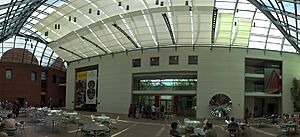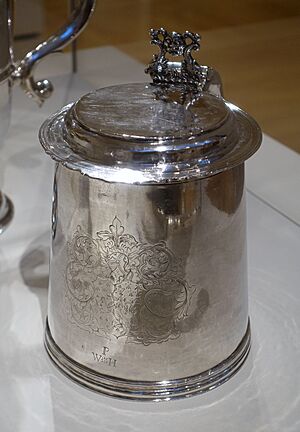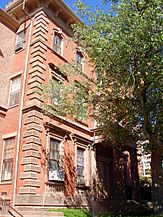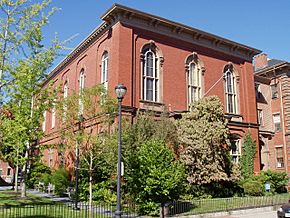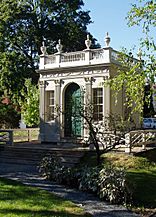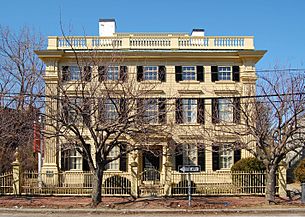Peabody Essex Museum facts for kids
 |
|
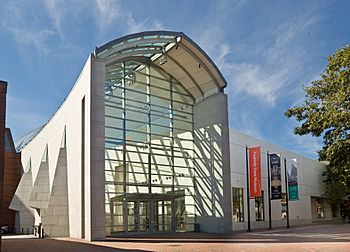
The main entrance to the museum
|
|
| Lua error in Module:Location_map at line 420: attempt to index field 'wikibase' (a nil value). | |
| Established | 1799 |
|---|---|
| Location | 161 Essex Street Salem, MA 01970 |
| Type | Art museum |
| Accreditation | AAM, NARM |
| Collections | American art, Asian art, maritime art |
| Collection size | 1.3 million |
| Public transit access |
Newburyport/Rockport Line
Salem Station |
The Peabody Essex Museum (PEM) in Salem, Massachusetts, is a super cool place to visit! It's one of the oldest museums in the United States, starting way back in 1799. PEM brings together amazing collections from two older museums: the Peabody Museum of Salem and the Essex Institute.
Today, PEM has about 1.3 million items, including incredible art from all over the world. It also takes care of twenty-two historic buildings. After expanding in 2019, PEM became one of the top 10 art museums in North America. It has over 840,000 pieces of art and history, covering maritime (ocean-related), American, Asian, Oceanic, and African art. Plus, it has two huge libraries with over 400,000 books!
Museum History
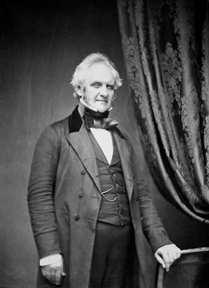
The Peabody Essex Museum was formed in 1992 when the Peabody Museum of Salem and the Essex Institute joined together. But the museum's story actually began much earlier, in 1799, with a group called the East India Marine Society.
This society was made up of ship captains and traders from Salem. They had a special rule: members had to collect "natural and artificial curiosities" from places far away, like beyond Africa's Cape of Good Hope or South America's Cape Horn. They also had to sail all the way around the world! This rule meant they brought back many unique and old items to the collection.
In the 1820s, the East India Marine Society built a special building called East India Marine Hall to keep their growing collection. This building is now a National Historic Landmark and is part of the museum today. In 1867, the collection and the building were taken over by the Peabody Academy of Science, which later became the Peabody Museum of Salem.
| How the Peabody Essex Museum started | |||||||||||||||||||||||||||||||||||||||||||||||||||||||||||||||||||||||||||||||||||||||||||||||||||||||||||||||||||||||||||||||||||||||||||||||||||||||||||||||||||||||||||||||||||||||
|---|---|---|---|---|---|---|---|---|---|---|---|---|---|---|---|---|---|---|---|---|---|---|---|---|---|---|---|---|---|---|---|---|---|---|---|---|---|---|---|---|---|---|---|---|---|---|---|---|---|---|---|---|---|---|---|---|---|---|---|---|---|---|---|---|---|---|---|---|---|---|---|---|---|---|---|---|---|---|---|---|---|---|---|---|---|---|---|---|---|---|---|---|---|---|---|---|---|---|---|---|---|---|---|---|---|---|---|---|---|---|---|---|---|---|---|---|---|---|---|---|---|---|---|---|---|---|---|---|---|---|---|---|---|---|---|---|---|---|---|---|---|---|---|---|---|---|---|---|---|---|---|---|---|---|---|---|---|---|---|---|---|---|---|---|---|---|---|---|---|---|---|---|---|---|---|---|---|---|---|---|---|---|---|
|
|||||||||||||||||||||||||||||||||||||||||||||||||||||||||||||||||||||||||||||||||||||||||||||||||||||||||||||||||||||||||||||||||||||||||||||||||||||||||||||||||||||||||||||||||||||||
Modern Museum Updates
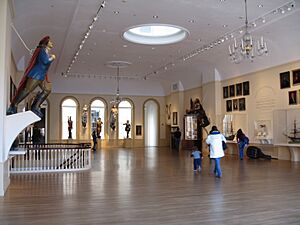
In 2003, the Peabody Essex Museum finished a huge renovation. They added a new wing, which more than doubled the space for showing art. This meant they could finally display many items that had been hidden away! At this time, the museum also opened the Yin Yu Tang House. This is a real Chinese house from the early 1800s that was carefully taken apart in China and rebuilt right on the museum grounds.
The museum continued to grow. In 2019, PEM opened another new wing. This addition included 15,000 square feet of new gallery space and a beautiful landscaped garden.
Museum Leadership
In 2021, Lynda Roscoe Hartigan became the museum's Director and CEO. She was the first woman to hold this important position at PEM. Before her, Dan Monroe was the director from 1993 to 2019.
Amazing Collections
The Peabody Essex Museum has many different collections from all over the world. Let's explore some of them!
African Art
PEM's African art collection has about 3,600 objects. People started collecting these pieces in the early 1800s. The collection includes ceremonial masks, pottery, woven baskets, and a special group of Ethiopian art. Many of these pieces are Christian icons and metalwork, showing traditions from Byzantine art.
American Art
The museum's American art collection is huge, with over 1,000 portraits. You can see works by famous artists like John Singer Sargent and Fitz Henry Lane. The collection also features furniture, folk art, and needlework. Because of the museum's history in New England, it has many decorative arts from the Northeastern United States.
Chinese Art
PEM's Chinese art collection has over 6,000 objects. It includes both old and new works, as well as art from different groups within China. You'll find ceramics, textiles, and beautiful calligraphy. This collection started in the 1700s when New England traders brought items back from China. The biggest piece in the museum is the Yin Yu Tang House, a Chinese home from the late 1700s.
Fashion and Textiles
The museum has one of the most important American clothing collections in the United States. It has examples from the early 1700s to today. Many pieces belonged to important families from New England, like the Crowninshields from Salem. The collection is strong in military uniforms and has many works by famous designers like Alexander McQueen and Iris Apfel.
Indian Art
The Peabody Essex Museum's Indian art collection has over 5,000 objects. It also has many works from Tibet and Nepal. PEM's Herwitz Gallery, which opened in 2003, is the first American museum gallery just for modern Indian art. The collection shows how Indian art changed over time, especially during colonial rule.
Japanese Art
With about 18,300 objects, PEM's Japanese art collection started when the museum began in 1799. It has many pieces from the Edo and Meiji periods, including armor, sculptures, painted scrolls, and furniture. Much of this collection came from Edward S. Morse, an early director of the museum, who collected many pieces during his trips to Japan.
Korean Art
The Peabody Essex Museum has about 1,800 pieces of Korean art. This includes ceramics, textiles, and painted screens. The collection began in 1883. Many pieces are from the Joseon dynasty, showing how art was a central part of everyday Korean life, rituals, and ceremonies.
Maritime Art
By the late 1700s, Salem was a very busy seaport. Trading furs, spices, and other goods brought a lot of wealth to the area. This long history of sea trade helped create PEM's maritime art collection, which is one of the best in the country. It has over 50,000 objects, like paintings, model ships, and scrimshaw (art made from whalebone or ivory). You can see everything from old navigation tools to modern art about sea life.
Native American Art
PEM's Native American art collection has over 20,000 objects. It includes masks, textiles, jewelry, clothing, and sculptures. There are also many pieces by modern Native American artists. The collection started even before the museum opened, as traders exchanged art objects with local tribes.
Oceanic Art
The Peabody Essex Museum's collection of Oceanic art has over 15,000 objects from more than 36 different island groups in Polynesia, Melanesia, and Micronesia. These objects include sculptures, weapons, and clothing made from traditional materials like porpoise teeth and human hair. The museum also has a large collection of Hawaiian art, with over 5,000 objects.
Photography
PEM's photography collection is its largest, with over 850,000 images! It started in 1840, just one year after photography was invented. It includes work by early photographers and a collection of rare Civil War photos. The collection shows many different subjects, from life in the Philippines to photos of the Great Depression.
Phillips Library
The museum has a huge collection of rare books and historical documents in the Phillips Library. In 2017, many of these historical documents were moved to a special storage facility in Rowley, Massachusetts.
Historic Buildings
The museum owns 24 historic buildings and gardens. Some of these are in the old Essex Institute grounds, which is now the Essex Institute Historic District. Five of these buildings are National Historic Landmarks, which means they are very important to the country's history. Some of these properties offer guided tours.
-
Plummer Hall (formerly Salem Athenaeum)
American Artists in the Collection
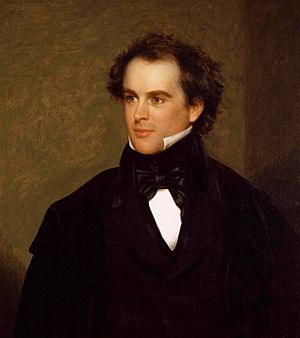
Here are some of the American artists whose work you can find at the museum:
- Clifford Warren Ashley
- James Bard
- Frank Weston Benson
- John Prentiss Benson
- James E. Buttersworth
- John Singleton Copley
- Michele Felice Cornè
- George Washington Felt (1776–1847)
- Alvan Fisher
- Fitz Hugh Lane
- Charles Osgood
- Frederic Remington
- George Ropes, Jr. (1788–1819)
- Robert Salmon
- John Singer Sargent
- William Pierce Stubbs
- Charles Wilkes
See also
- Huangshan District
- Essex Institute Historic District
- List of maritime museums in the United States


